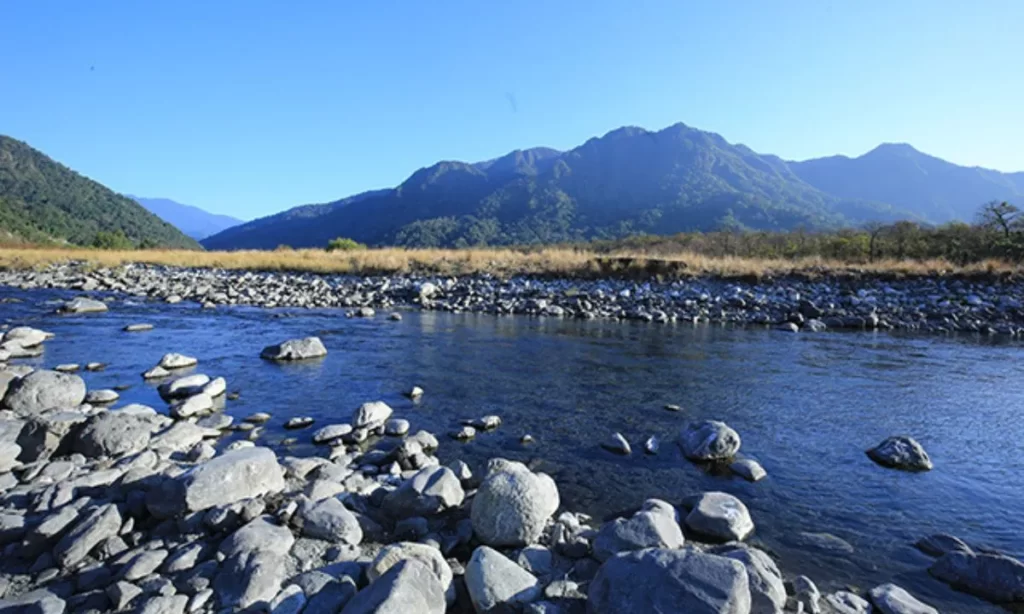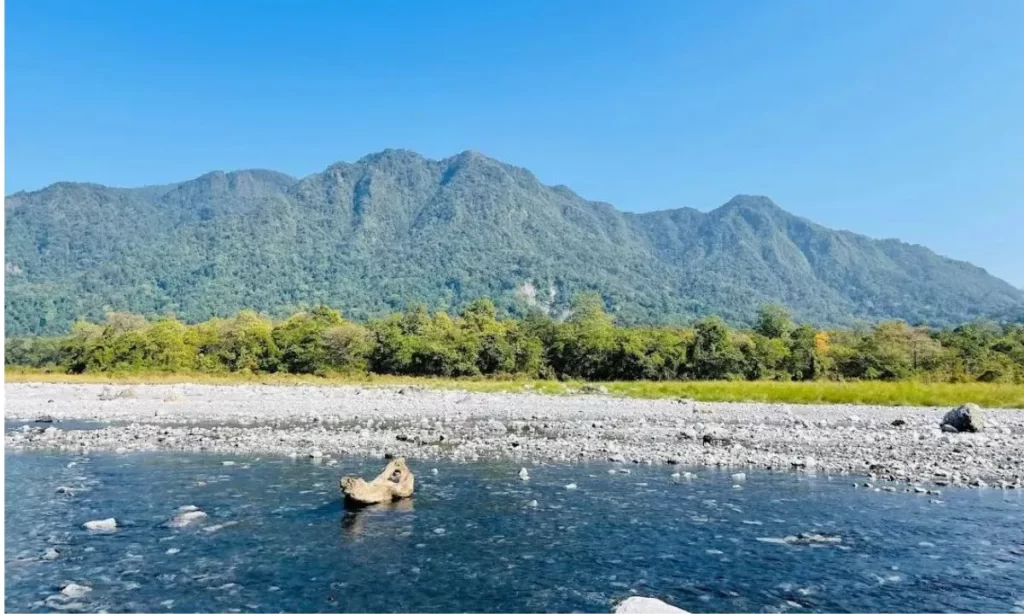Kalamati picnic spot is nestled in the heart of Assam in the lush greenery and serene landscapes of the Manas Reserve Forests, lies a captivating picnic spot known as Kalamati. This enchanting location, also referred to as the Blind Spider or Kanamakra and it is a sanctuary for wildlife enthusiasts, nature lovers and anyone seeking a peaceful retreat from the hustle and bustle of city life.
Kalamati with its unique black soil rich in salt attracts a plethora of wildlife including elephants from neighboring forests such as Kuklung, Basuki, Mwidert Khor, Ajimora, and Panbari making it an idyllic spot for a picnic with a wild twist.
The Allure Of Kalamati
Kalamati’s allure picnic spot is not just in its wildlife but also in its geographical placement and the rich biodiversity that surrounds it. Located in the Chirang district within the Bodoland Territorial Area Districts (BTAD) of Assam, it forms an integral part of the western buffer zone of the renowned Manas National Park. The area is a testament to nature’s splendor with its black soil deposits known for their salinity which is a natural magnet for animals seeking salt-licks.

Flora And Fauna
Kalamati picnic spot and its environment are a hotspot for biodiversity. The area is teeming with medicinal plants, edible wild fruits and herbs. It’s a haven for the golden langur which delights in the variety of orchids found here alongside a host of other wildlife including wild dogs, rhesus macaques, spotted deer, leopards and many more. The presence of rare and endemic species like the Asian elephant, Indian bison, royal tiger and various birds and reptiles adds to the region’s ecological wealth.

How To Reach Kalamati Picnic Spot
Reaching Kalamati is an adventure. The picnic spot is accessible from Koilamoila, the nearest marketplace and is located roughly 39 km from Bongaigaon town, the closest railway station. Alternatively, visitors can approach from Chapaguri crossing rivers and streams to cover a distance of 24 km. For those coming from Guwahati, Kalamati is a 220 km drive along NH-31A offering a scenic route into the heart of Assam’s wilderness.
Kalamati Picnic Spot From Bongaigaon
Kalamati Picnic Spot From Bongaigaon By Road:
- Via Bijni Route: The most common route starts from Bongaigaon, the nearest major town with a railway station. From Bongaigaon, you can hire a taxi or catch a shared Sumo to reach Kalamati via Bijni. This route covers approximately 39 km and offers a relatively smooth ride with scenic views along the way.
- Via Chapaguri Route: An alternative route from Bongaigaon involves traveling via Chapaguri. This path is shorter about 24 km but may require crossing rivers and navigating through more rugged terrain which can be an adventure in itself. It’s a great option for those looking for a bit more adventure.
Kalamati Picnic Spot From Guwahati
Kalamati Picnic Spot From Guwahati By Road:
Guwahati is the capital city of Assam that serves as a primary gateway to the state for many travelers. From Guwahati, Kalamati can be reached by road via National Highway 31A.
Take NH-31A from Guwahati towards Bongaigaon and then proceed as per the directions mentioned above from Bongaigaon to Kalamati. The distance from Guwahati to Koilamoila (the entry point to Kalamati) is approximately 220 km. The journey offers travelers a chance to experience the diverse landscapes of Assam from bustling towns to serene countryside and lush green forests.
Best Time To Visit Kalamati Picnic Spot
The ideal time to visit Kalamati is between winter and spring when the weather is most favorable. The monsoon season while bringing life to the forest can make navigation challenging for tourists. Summers can be hot and humid making the cooler months from November to March the best time for a picnic and exploration.
Additional Travel Tips Kalamati Picnic Spot
- Hire a Local Guide: Considering the remote location of Kalamati and the potential for navigation challenges, hiring a local guide or arranging for a local driver familiar with the routes can enhance your travel experience.
- Check Vehicle Condition: If you’re renting a car or taking a shared taxi and ensure the vehicle is in good condition as parts of the journey may involve rough terrain.
- Travel Prepared: Bring along essentials such as water, snacks, a first-aid kit and possibly some insect repellent given the natural setting of Kalamati.
- Stay Informed: Before embarking on your journey, check for any travel advisories or restrictions, especially during the monsoon season when some routes may be less accessible.
Read More: Dabbaguli Picnic Spot A Riverside Haven Near Bangalore
Conclusion
Kalamati picnic spot is more than just a picnic spot, it’s a gateway to understanding the delicate balance between nature and human livelihood. It invites visitors to not only enjoy its serene beauty but also to reflect on the importance of preserving such natural treasures for future generations. Whether it’s the thrill of spotting wildlife, the calm of being surrounded by nature or the adventure of reaching this hidden gem, Kalamati promises an unforgettable experience for all who venture their way.
Frequently Asked Questions on Kalamati Picnic Spot
Kalamati is renowned for its unique black soil rich in minerals and salt licks which attract a variety of wildlife including elephants from neighboring forests. It’s part of the Manas Reserve Forests near the Manas National Park and is celebrated for its natural beauty and biodiversity.
The ideal time to visit Kalamati is between the winter and spring months when the weather is pleasant. It’s advisable to avoid the monsoon season due to heavy rains that can make access difficult and the summer months can be quite hot and humid.
Kalamati is a natural spot within a reserve forest area, so facilities are minimal to preserve its ecological balance. Visitors should be prepared to carry essentials like water, food and firstaid supplies.
Visiting Kalamati is generally safe but as with any wilderness area, it’s important to respect nature, follow local guidelines and preferably travel in groups.
Since Kalamati is within a reserve forest area, it’s advisable to check with the local forest department or a local NGO like New Horizon, involved in conservation efforts for any permissions or guidelines for visitors.
Read More: Pahar Bhanga Picnic Spot: Hidden Gem In Jharkhand
